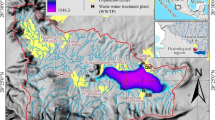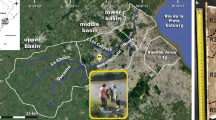Abstract
Concentrations of heavy metals (Cu, Ni, Cd, Pb, Cr, and Zn) in bottom sediments, water, snow, and biota of the Uvod Reservoir, as well as of rare-earth elements (Ce, Dy, Er, Eu, Gd, Ho, La, Lu, Nd, Pr, Sm, Tb, Y, and Yb) in its water are assessed. Geochemical studies of concentrations of Cu, Ni, Cd, Pb, Cr, and Zn in soils, water, and snow allow us to state that the metals enter the reservoir mostly from natural sources; however, some part of them are of anthropogenic origin. The sum of concentrations of light rare-earth elements (La, Ce, and Nd) make almost the total of all rare-earth elements in the reservoir—from 70 to 97%, depending on the sampling site. The highest concentrations of metals (and the highest percentage of their labile forms) are recorded in the Priplotinnyi and Kolbaskinskii (in macrophite deposits) pools and at the site of water inflow from the Volga-Uvod canal. There is also reason to suppose a secondary entry of the elements under study into the water mass. The largest variations in metals’ concentrations are observed during the periods of spring and autumn floods, when a great quantity of terrigenous suspended matter enters the water body. The distribution of the above metals and rare-earth elements in water is uneven; their highest concentrations are observed in the site of water inflow from the canal and in the Uvod River (the latter is likely to be due to the effect of the settlement of Pistsovo). The analysis of biota (fennel-leaved pondweed and zooplankton) has shown that the Uvod Reservoir is polluted with heavy metals.
Similar content being viewed by others
References
Gapeeva, M.V., Zakonov, V.V., and Gapeev, A.A., Localization and Distribution of Heavy Metals in BedLoad Deposits of the Upper Volga Reservoirs, Vodn. Resur., 1997, vol. 24, no. 2, pp. 174–180 [Water Resour. (Engl. Transl.), vol. 24, no. 2, pp. 153–159].
Grinevich, V.I., Zakharova, S.A., Kostrov, V.V., and Chesnokova, T.A., Forms of Occurrence of Metals in the Near-Surface Water Layer in the Uvod’skoe Reservoir, Vodn. Resur., 1997, vol. 24, no. 6, pp. 740–743 [Water Resour. (Engl. Transl.), vol. 24, no. 6, pp. 686–689].
Mikryakova, T.F., Accumulation of Heavy Metals by Macrophytes at Different Levels of Pollution of Aquatic Medium, Vodn. Resur., 2002, vol. 29, no. 2, pp. 253–255 [Water Resour. (Engl. Transl.), vol. 29, no. 2, pp. 230–232].
SanPiN 2.1.4.1074-01 (Sanitary Regulations and Standards 2.1.4.1074-01), Moscow: FTs Gosepidemnadzora Minzdrava Rossii, 2002.
Ekologiya, bioraznoobrazie i sistematika vodnykh bespozvonochnykh (Ecology, Biodiversity, and Systematics of Aquatic Invertebrates), Available from VINITI, 2001, no. 665-V2001.
Aubert, D., Stille, P., Probst, A., et al., Characterization and Migration of Atmospheric REE in Soils and Surface Waters, Geochim. Cosmochim. Acta, 2002, vol. 66, no. 19, pp. 3339–3350.
Demirezen, D. and Aksoy, A., Accumulation of Heavy Metals in Typha Angustifolia (L.) and Potamogeton pectinatus (L.) living in Sultan Marsh (Kayseri, Turkey), Chemospere, 2004, vol. 56, no. 7, pp. 685–696.
Farkas, A., Salanki, J., and Varanka, I., Crustaceans as Biological Indicators of Heavy Metal Pollution in Lake Balaton (Hungary), Hydrobiologia, 2003, vol. 506, no. 1, pp. 359–364.
Laia, Y., Limin, Y., Huanga, B., and Wang, Q., Subcellular Distribution of Rare Earth Elements and Characterization of Their Binding Species in a Newly Discovered Hyperaccumulator Pronephrium Simplex, Talanta, 2006, vol. 70, no. 1, pp. 26–31.
Loring, D., The Li Solution-a New Approach for the Granulometric Normalization of Trace Metal Data, Mar. Chem., 1990, vol. 29, no. 2, pp. 155–168.
Qian, J., Xiao-quan, S., Zi-jian, W., and Qiang, T., Distribution and Plant Availability of Heavy Metals in Different Particle-Size Fractions of Soil, The Sci. Total Environ., 1996, vol. 187, pp. 131–141.
Ramesh, R., Ramanathan, A.L., James, R., et al., Rare Earth Elements and Heavy Metal Distribution in Estuarine Sediments of East Coast of India, Hydrobiologia, 1999, vol. 397, pp. 89–99.
Van Der Gaag, Stortelde, P.B.M., and Van Der Kooij, I.A., Ecotoxikologishe Acpecten Van Het Begrip Basiskwaliteit Voor Water: Enn Pragmatishe Benadering, H 2 O, 1989, vol. 11, no. (22), pp. 322–346.
Author information
Authors and Affiliations
Additional information
Original Russian Text © A.V. Dolotov, M.V. Gapeeva, E.V. Kozlovskii, 2010, published in Vodnye Resursy, 2010, Vol. 37, No. 1, pp. 60–66.
Rights and permissions
About this article
Cite this article
Dolotov, A.V., Gapeeva, M.V. & Kozlovskii, E.V. Assessment of the Uvod Reservoir pollution with heavy metals. Water Resour 37, 58–64 (2010). https://doi.org/10.1134/S0097807810010045
Received:
Published:
Issue Date:
DOI: https://doi.org/10.1134/S0097807810010045




